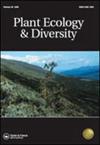高山苔原的树木殖民化:高山邻居帮助晚生而不是早生的针叶树幼苗
IF 1.6
4区 生物学
Q2 PLANT SCIENCES
引用次数: 3
摘要
摘要背景:气候变化预计将改变全球树线的海拔和纬度。种子发芽和幼苗存活是树系扩展的关键控制因素。邻近的高山植物,无论是通过争夺资源还是通过改变小气候,也会影响高山地区的幼苗。随着气候变暖,高山植物物种之间可能会或多或少地发生强烈的相互作用。目的:确定在环境和气候变化的情况下,建立的树苗和高山草本植物是否对高山植物邻居同样敏感。方法:我们进行了积极的加热、浇水,并移除了与新兴针叶树幼苗和一种高山草本植物相邻的所有植物。结果:与柔性松相比,Engelmanii云杉幼苗在去除邻居后3周的存活率较低,1年后仅在浇水小区存活。松树幼苗通过降低光合作用的量子产量(ξPSII)来响应邻居的移除。与压力梯度假说的预期相反,在Chionophila jamesii的低海拔范围限制附近,没有邻居的生存率降低。结论:柔性松在高山地区具有更高的扩张潜力,而恩格尔曼云杉需要潮湿的条件,邻居可以为其扩张范围提供便利。这意味着P.flexilis可能会扩大范围,对高山植物多样性和生态系统功能产生影响。本文章由计算机程序翻译,如有差异,请以英文原文为准。
Colonisation of the alpine tundra by trees: alpine neighbours assist late-seral but not early-seral conifer seedlings
ABSTRACT Background: Climate change is projected to alter the elevation and latitude of treeline globally. Seed germination and seedling survival are critical controls on treeline expansion. Neighbouring alpine plants, either through competition for resources or through altered microclimate, also affect seedlings emerging in the alpine zone. With warming, alpine plant species may interact with each other more or less strongly. Aims: To determine whether establishing tree seedlings and an alpine herb are similarly sensitive to alpine plant neighbours under ambient and altered climate. Methods: We imposed active heating, watering, and removed all plants adjacent to emerging conifer seedlings and an alpine herb. Results: Picea engelmannii seedlings showed lower survival compared with Pinus flexilis 3 weeks following neighbour removal, and after 1 year only survived in watered plots. Pinus seedlings responded to neighbour removal by lowering the quantum yield of photosynthesis (ϕPSII). Contrary to expectations from the stress gradient hypothesis, survival was reduced without neighbours near the low-elevation range limit of Chionophila jamesii. Conclusions: Pinus flexilis has higher expansion potential into the alpine, while Picea engelmannii requires moist conditions that could be facilitated by neighbours to expand its range. This implies likely range expansion by P. flexilis with consequences for alpine plant diversity and ecosystem function.
求助全文
通过发布文献求助,成功后即可免费获取论文全文。
去求助
来源期刊

Plant Ecology & Diversity
PLANT SCIENCES-
CiteScore
3.30
自引率
0.00%
发文量
26
审稿时长
3 months
期刊介绍:
Plant Ecology and Diversity is an international journal for communicating results and novel ideas in plant science, in print and on-line, six times a year. All areas of plant biology relating to ecology, evolution and diversity are of interest, including those which explicitly deal with today''s highly topical themes, such as biodiversity, conservation and global change. We consider submissions that address fundamental questions which are pertinent to contemporary plant science. Articles concerning extreme environments world-wide are particularly welcome.
Plant Ecology and Diversity considers for publication original research articles, short communications, reviews, and scientific correspondence that explore thought-provoking ideas.
To aid redressing ‘publication bias’ the journal is unique in reporting, in the form of short communications, ‘negative results’ and ‘repeat experiments’ that test ecological theories experimentally, in theoretically flawless and methodologically sound papers. Research reviews and method papers, are also encouraged.
Plant Ecology & Diversity publishes high-quality and topical research that demonstrates solid scholarship. As such, the journal does not publish purely descriptive papers. Submissions are required to focus on research topics that are broad in their scope and thus provide new insights and contribute to theory. The original research should address clear hypotheses that test theory or questions and offer new insights on topics of interest to an international readership.
 求助内容:
求助内容: 应助结果提醒方式:
应助结果提醒方式:


